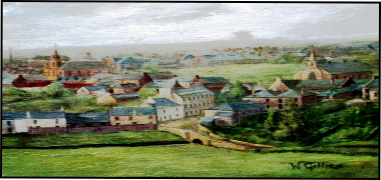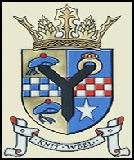Stewarton & District Historical Society Scottish Charitable Incorporated Organisation : SC011194.

Dunlop Street 1970D

Stewarton Viaduct 2008
Coat of Arms reproduced by permission of Stewarton Community Council

Springwell Place 1860

Site produced by
“Davie McKie’s Web Designs.”
Updated
26th January 2024
C -
and the Cuninghames
CORSEHILL (& CUNINGHAMES OF)
Sadly Corsehill Castle no longer exists. The ruin between the road and the railway
on the way to Dunlop is known to-
The site of Corsehill Castle would have been at the top of Bowes Rigg, as there
was a tree-
Before the castle was demolished, an inventory was taken of the contents, and
the Society have a copy of what appear to be the 'remnants' that were left behind.
This is dated 1730, following the death of Sir Alexander Cuninghame, and gives us
some idea of the size of the castle and its contents;-
Dining Room (or Great Hall) -
Chairs, table, books, clothes and wigs, bedsteads, carpet, mirror, bedsteads, wall hangings, etc
Also -
Closet of the Dining Room -
feather bed, curtains, old chest containing meal and an old corn chest
Kitchen -
kitchen utensils, irons, spinning wheels,boots and saddles, a cheese press
Crewhouse -
4 small old trees, 4 milk cans, pewter plates, trenchers & tankards , candlesticks, silver spoons, blankets, napkins, tablecloths, blunderbuss (gun), 1 picture.
On the Lands -
8 acres of corn and a few peas
2 acres of growing grass
5 milk cows
six quoys (sic)
12 sheep
The Cuninghame family had held great power in the town.The Laird chaired meetings of the Baron Court, which was the only form of law and order in the 17th and 18th centuries, and he dealt with offences such as sheep stealing, land boundary disputes, assaults, etc., dealing out his own justice. The Society have a collection of some of these 'trials' in their records.
When a new Parish Church was built in 1696, an upper area known as the Corsehill Gallery was incorporated into the main building.The Cuninghames of Corsehill had, until then, used a stair of their own to reach their seats in the upper part of the Church so that they did not need to mix with the 'common crowd' .
The only evidence remaining of Corsehill seems to be in the form of a sundial which
is described as follows;-
'The plinth has the Cuninghame arms and the initials SAC DMS, for Sir Alexander
Cuninghame (d. 1685) and his wife, Dame Margaret Stewart (m. 1665). They lived at
Corsehill, near Stewarton, so the dial was probably made there and taken to Lainshaw
when the family moved in 1779. It came to Hensol (in Galloway) in 1920. In style,
both the dial and plinth closely resemble one at Ladyland, at Kilbirnie, dated 1673;
both have extra points between the horns of the hemicylinders, making their stars
12-
THE ORIGINS OF THE CUNINGHAME OF CORSEHILL FAMILY
Alexander Cuninghame 1st Earl of Glencairn died 1488 -
Robert Cuninghame 2nd Earl of Glencairn died 1489
Cuthbert Cuninghame 3rd Earl of Glencairn died 1541
William Cuninghame 4th Earl of Glencairn, Lord High Treasurer, died 1547
Alexander Cuninghame, 5th Earl of Glencairn died 1574
whose younger brother was -
Andrew Cuninghame 1st of Corsehill died 1544
Cuthbert Cuninghame 2nd of Corsehill died 1575
Patrick Cuninghame 3rd of Corsehill died 1588 (he may have been implicated in the death of the Earl of Eglinton at Stewarton in April 1586 and was killed by the Montgomeries two years later).
The Corsehill baronetcy was created in 1643 so the title changes;-
Sir Alexander Cuninghame, 1st Baronet (c. 1643-
Sir Alexander Cuninghame, 2nd Baronet (died 1730)
Sir David Cuninghame, 3rd Baronet (died 1770) -
Sir Walter Montgomery-
Sir David Montgomery-
Sir James Montgomery-
Sir Alexander David Montgomery-
Sir Thomas Montgomery-
Sir William Montgomery-
Sir Thomas Andrew Alexander Montgomery-
Sir (William) Andrew Malcolm Martin Oliphant Montgomery-
He married in 1956, but died without issue 3 years later.
Sir John Christopher Foggo Montgomery Cuninghame of Corsehill, 12th Baronet
of Corsehill (born 24 July 1935). Montgomery Cuninghame (following a ruling by the
Lord Lyon in 1996 he de-

Ian’s A-